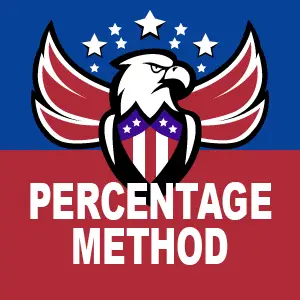The Percentage Method

As well as using ratios, pot odds can also be calculated using percentages. The percentage method is a straightforward approach in poker for determining the probability of completing a winning hand. Instead of using ratios, this method converts the likelihood of hitting a needed card into a percentage.
By doubling the number of outs and adding one, players can quickly estimate their chances of success. This percentage is then compared to the pot odds, allowing players to assess whether a bet is worthwhile. The percentage method simplifies the decision-making process, making it easier for players to evaluate the potential profitability of their plays.
Example scenario
You’re in a pot with 7 of Hearts9 of Clubs – don’t ask us why, it was your decision. The flop has come down 6 of Spades8 of Diamonds[Ac] and you’ve found yourself with a nice little up-and-down straight draw or an ‘open-ender’. Your opponent makes a bet of $30 into a pot of $60, so the total pot is now $90.
Just like we did in the Ratio Method, we need to find our Card Odds. To make our straight, we are going to need to hit a five or a ten. There are four of each in the deck. That gives us a total of 8 cards that can help us. Cards that can help us improve our hand to secure a win are called ‘outs’. So, in this case, we have 8 outs.
Calculating the percentage chance
To work out the percentage chance of making our straight, all we need to do is double our outs and add one.
- 8 outs x 2 = 16
- 16 + 1 = 17%
We have a 17% chance of hitting our straight.
Weighing card odds against pot odds
We then need to take this percentage chance and weigh it against our Pot Odds.
Our opponent’s $30 bet made the total pot $90. After we make the call, the pot will be $120. In other words, we are calling $30 for a chance to win $120. Basic mathematics says that our $30 call will make up 25% of that $120.
- Our Card Odds are 17%
- Our Pot Odds are 25%
Because we know our chances of making our hand on the turn are only 17%, we should only really be calling 17% of the total pot. It should go without saying, then, that 25% is simply too much to pay – this should be an easy fold. Unlike the example used in our article about calculating The Ratio Method, if we continually made this call over time, we would be losing money more often than we won it and not making enough each time we won to cover our previous losses.
Key takeaway when using the percentage method
You should only be making this sort of call in a situation where the percentage chance of making your hand is greater than the percentage of the pot you are required to call in order to remain in the hand.